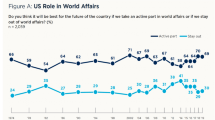Abstract
Presidents understand that reelection, reputation, and ultimately their place in history are intimately tied to their ability to get policy initiatives through Congress. Given the vital role Congress plays in the legislative process, presidents must carefully cultivate their relationship with members of the House and Senate to achieve policy successes. Roosevelt is remembered for social security and the GI Bill (among many other things), while Johnson successfully passed both the 1964 Civil Rights Act and the 1965 Voting Rights Act. Bush 43 managed to pass the Tax Relief Act of 2001 as well as implement a new prescription drug program for seniors. President Obama will likely be remembered for the passage and upholding by the Supreme Court of his signature healthcare legislation—the Affordable Care Act. Compared to tenures of the other branches, the president’s window for policy movement is short so they are naturally in a greater hurry to accumulate a policy record. Such legislative victories ultimately cement a place in history for presidents, but they also help fashion a reputation for political effectiveness that can strengthen a president’s influence in Congress.
Access this chapter
Tax calculation will be finalised at checkout
Purchases are for personal use only
Preview
Unable to display preview. Download preview PDF.
Similar content being viewed by others
Notes
William G. Howell and Jon C. Pevehouse, While Dangers Gather: Congressional Checks on Presidential War Powers (Princeton: Princeton University Press, 2007).
Barbara Hinckley, Less than Meets the Eye: Foreign Policy Making and the Myth of an Assertive Congress (Chicago: University of Chicago Press, 1994). Also see
Bryan W. Marshall and Patrick J. Haney, “Aiding and Abetting: Congressional Complicity in the Rise of the Unitary Executive,” in The Unitary Executive and the Modern Presidency, ed. Ryan J. Barilleaux and Christopher S. Kelley (College Station: Texas A&M University Press, 2010).
Edwin S. Corwin, The President: Office and Powers, 1787–1984: History and Analysis of Practice and Opinion, 5th Revised ed. (New York: New York University Press, 1984).
Neustadt, Richard E., Presidential Power (New York: John Wiley & Sons, 1960).
Douglas L. Kriner, After the Rubicon: Congress, Presidents, and the Politics of Waging War (Chicago: University of Chicago Press, 2010).
Terry Moe, “The Politicized Presidency,” in The New Direction in American Politics, ed. John E. Chubb and Paul E. Peterson (Washington, D.C.: The Brookings Institution, 1984). Reprinted in
James P. Pfiffner, ed., The Managerial Presidency (Pacific Grove, CA: Brooks-Cole, 1991).
David Brulé, “Congressional Opposition, the Economy, and U.S. Dispute Initiation, 1946–2000,” Journal of Conflict Resolution, 2006, Volume 50, pp. 463–483. Also see
David Brulé, Bryan W. Marshall and Brandon C. Prins, “Opportunities and Presidential Uses of Force: A Selection Model of Crisis Decision-Making,” Conflict Management and Peace Science, 2010, Volume 27, Number 5, pp. 486–510.
The basic dataset was built using the EUGene data generation software program. See D. Scott Bennett and Alan Stam, “EUGene: A Conceptual Manual,” International Interactions, 2000, Volume 26, pp. 179–204.
David R. Mayhew, Congress: The Electoral Connection (New Haven and London: Yale University Press, 1974).
Jeffrey Pickering and Emizet Kisangani, “Democracy and Diversionary Military Intervention: Reassessing Regime Type and the Diversionary Hypothesis,” International Studies Quarterly, 2005, Volume 49, Number 1, p. 29.
Jeffrey Pickering and Mark Peceny, “Forging Democracy at Gunpoint,” International Studies Quarterly, 2006, Volume 50, pp. 539–559.
Emizet F. Kisangani and Jeffrey Pickering, “Diverting with Benevolent Military Force: Reducing Risks and Rising Above Strategic Behavior,” International Studies Quarterly, 2007, Volume 51, pp. 277–299. Also see
Emizet F. Kisangani and Jeffrey Pickering, “Democratic Accountability and Diversionary Force: Regime Types and the Use of Benevolent and Hostile Military Force,” Journal of Conflict Resolution, 2007, Volume 55, pp. 1021–1046.
In addition to IMI, we also test our argument using the Military Interventions by Powerful States (MIPS) dataset collected by Patricia Sullivan and Michael Koch. These data record military uses of force that involve the “official deployment of at least 500 regular military personnel (ground, air, or naval) to attain immediate-term political objectives through action against a foreign adversary.” We use these data as an additional assessment of Party Cover using interventions that are more clearly coercive in nature and politically risky. Figure 15.2 illustrates the frequency of IMI humanitarian and strategic interventions, as well as MIPS interventions by the U.S. from 1950–2000. See Patricia L. Sullivan and Michael T. Koch, “Military Interventions by Powerful States,” Journal of Peace Research, 2009, Volume 46, pp. 707–718.
David B. Carter and Curtis S. Signorino, “Back to the Future: Modeling Time Dependence in Binary Data,” Political Analysis, 2010, Volume 18, pp. 271–292.
Brandon C. Prins and Mark Souva, “The Use of U.S. Military Force,” in The Handbook of American Foreign Policy, ed. Steven Hook and Christopher Jones (New York: Routledge Press, 2011).
Editor information
Copyright information
© 2014 R. Ward Holder and Peter B. Josephson
About this chapter
Cite this chapter
Marshall, B.W., Prins, B.C. (2014). The Politics of Presidential Foreign Policy: Unilateral Authority and the Role of Congress. In: Holder, R.W., Josephson, P.B. (eds) The American Election 2012. Elections, Voting, Technology. Palgrave Macmillan, New York. https://doi.org/10.1057/9781137389220_16
Download citation
DOI: https://doi.org/10.1057/9781137389220_16
Publisher Name: Palgrave Macmillan, New York
Print ISBN: 978-1-349-48396-9
Online ISBN: 978-1-137-38922-0
eBook Packages: Palgrave Political Science CollectionPolitical Science and International Studies (R0)




